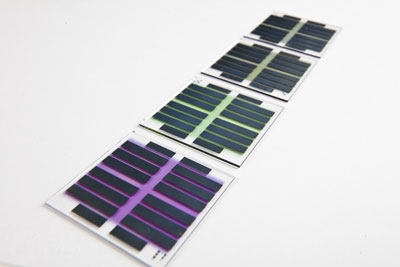| Oct 28, 2011 |
European collaboration towards efficient, low-cost tandem organic solar cells
|
|
(Nanowerk News) Imec and its 16 project partners have announced that they have launched the European FP7 project X10D, a project aimed at developing tandem organic solar cells with an increased conversion efficiency and lifetime, and a decreased production cost. The ultimate goal of the X10D project is to bring organic photovoltaic technologies (OPV) towards introduction into the competitive thin-film PV market.
|
|
Organic solar cells hold the promise of low-cost production and high throughput, both essential parameters for the uptake of a new technology by the PV industry. However, current OPV technologies are unstable when exposed to the ambient environment, and their power conversion efficiencies are not sufficient to be viable alternatives to the current dominating silicon photovoltaic technologies. By applying new designs and architectures, materials and manufacturing technologies, the X10D project aims at increasing the power conversion efficiency to achieve at least a 12% on cell level (1cm²), and 9% on module level (100 cm²). Moreover, the X10D project has set its goal to guarantee a minimum of 20 years lifetime for OPV modules on glass, and 10 years on foil, and to decrease the cost below 0.70 €/Watt-peak.
|
 |
| Organic solar cells on glass plates. These are tandem solar cells: two planar heterojunction cells are stacked on top of each other. In this way, the efficiency of organic solar cells can be increased. A power conversion efficiency of 5.15% was achieved, which is a 40% improvement over single devices. An innovative feature of these tandem cells is the all-evaporated interconnection scheme based on an electron-transport layer, metal nanoparticles and a hole-transport layer. The goal is to screen candidate materials with absorption spectra at even higher wavelengths and to use these in a stack of 3 or more cells, eventually targeting efficiencies over 10%.
|
|
X10D gathers the available OPV knowledge and expertise from leading universities, research institutes and companies in Europe. Furthermore, X10D brings together a complete and unique OPV research and development consortium covering both solution-processed as well as small molecule-based OPV expertise. Each segment of the value chain is represented in the project: materials development and up-scaling, device development and up-scaling, large-area deposition equipment and processes, novel transparent conductors, laser scribing equipment and processes, encapsulation technologies, energy, life-cycle, and cost analysis and finally end-users.
|
|
Within the framework of the X10D project, imec as project coordinator, collaborates with the Commissariat à l'Energie Atomique et aux Energies Alternatives – CEA (France), Stichting Energieonderzoek Centrum Nederland – ECN (The Netherlands), Bayerisches Zentrum für Angewandteenergieforschung – ZAE EV (Germany), Heliatek GMBH (Germany), IKERLAN S.COOP. (Spain), Imperial College of Science, Technology and Medicine (UK), Universidad Autonoma de Madrid (Spain), Technische Universiteit Eindhoven (The Netherlands), Nederlandse Organisatie voor Toegepast Natuurwetenschappelijk Onderzoek – TNO (The Netherlands), The Solar Press UK Limited (UK), Stork Prints B.V. (The Netherlands), SOLVAY SA (Belgium), VDI/VDE Innovation + Technik GMBH (Germany), AGFA-Gevaert N.V. (Belgium), 3D-Micromac AG (Germany), and Arkema France SA (France). The X10D project is partly funded by the European Commission (FP7/2007-2013).
|

